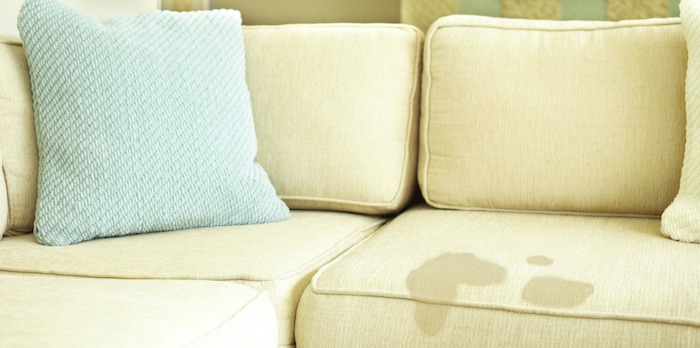
Dirt and stains can plague the couches and couch cushions of even the cleanest of all homes. From accidental spills and muddy pet paws to dirt that has built up over time, getting stains on the upholstery – and removing them – is just a part of the circle of life.
We have made couch cleaning less daunting with this step-by-step guide on how to clean a couch stain. When you need help cleaning your well-loved sofa, armchair or your favorite La-Z-Boy recliner, whatever the upholstery type, we are here to help walk you through it. Learning how to clean a couch is easy with LoadUp’s simple guide!
How to Clean Any Couch:
**Click to auto scroll by section
- Gather Your Cleaning Supplies
- Always Start With Vacuuming The Couch
- Find Your Couch’s Specific Cleaning Code
- Understanding Upholstery Fabric Cleaning Codes
How to Clean Your Couch (All Upholstery Types)
Just like other high traffic areas in your house, couches are heavily used and susceptible to dirt, stains and pet hair. Regardless of the type of couch you have, there are several common steps to follow. Once you have completed these, read on to find step-by-step cleaning instructions your specific couch type.
Couches that are badly stained might not be able to be cleaned successfully. When cleaning your couch or other upholstered furniture becomes too much effort, we’ll take it off your hands for less. Save yourself the time and energy it takes to lug heavy furniture down to the curb and call LoadUp. We offer next day service in most areas!
Need eco-friendly couch disposal? LEARN MORE ❯
Step 1. Gather Your Supplies
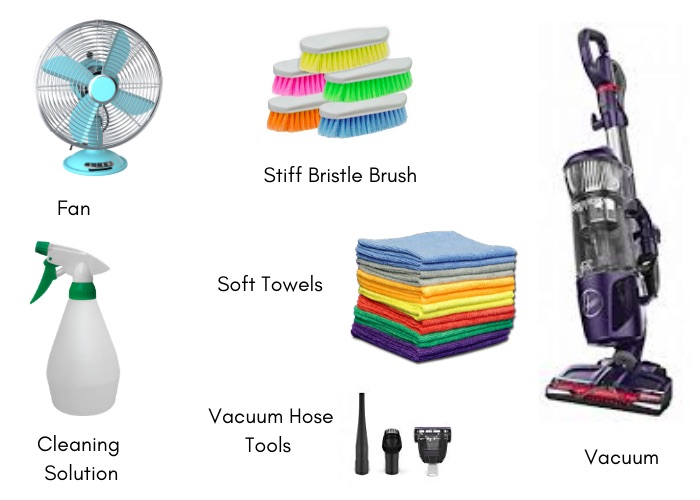
Tools for Cleaning a Couch
- Vacuum w/ Hose and Tool Attachments
- Water, Solvent or a Mixture of Both (*Depends on upholstery type)
- Stiff Bristle Brush (Do NOT use a wire brush)
- Soft Towels
- Fan

Step 2. Vacuum
The first step to cleaning your couch is to vacuum it. Your vacuum’s hose, brush and crevice tool attachments will make vacuuming hard to reach dirt and hair much easier.
If you don’t have an upright or canister vacuum with a hose and tool attachments, you can always use a handheld vacuum. Handheld vacuums don’t have the same suction power as upright or canister vacuums. If you’re using a handheld vacuum, or your vacuum doesn’t have the suction power that it used to, follow the Pro Tip below.
🧹 PRO TIP: For set-in dirt and stains, use a stiff brush to loosen up dust, dirt, crumbs and other debris. Lightly sprinkle baking soda on your couch, paying special attention to stains. Let baking soda sit on your sofa for 20 to 30 minutes before vacuuming.

Step 3. Check Couch Cleaning Codes
If you’ve ever removed your couch cushions, then you’ve probably seen them: one or two tags with very small print that are sewn into the seam of your couch’s upholstery. Well, these tags actually have a purpose! Any type of fabric, microfiber or leather upholstery will have cleaning and care instructions printed on these tags. They will either list the appropriate cleaning code (W, S/W, S or X) for your type of couch or they will give more detailed instructions for proper care and cleaning.
The manufacturer tags are crucial to success when cleaning your couch or other upholstered furniture. Using the wrong cleaning solution on your couch can leave an unsightly stain, and may even permanently damage the couch.
Now that you’ve found the right cleaning code for your couch, you’re ready to start treating dirt and stains. Curious about what these cleaning codes mean? The handy table below will make you an expert in deciphering cleaning codes in no time.
| Cleaning Code | Definition | What it Means |
| W | Water-Based Only | Use only water or a water-based cleaner to clean fabric. Water-based cleaners are primarily composed of water or mild, bleach-free cleaners like baking soda. |
| S | Solvents Only | Use only solvents to clean fabric. Solvents are solutions that use cleaning chemicals as the main ingredient. |
| S/W | Solvents and Water-Based | You can safely both solvents and water-based solutions. | X | Professional Only | Don’t attempt to clean at home. This type of upholstery requires professional cleaning. |
Couch Cleaning Codes Defined
- “W” Upholstery Examples: Vinyl, faux leather.
Stains on fabrics under this code can be cleaned with water or awater-based fabric cleaner. Simple to clean and care for, durable “W” fabrics easily withstand wear and tear and stains. - “S” Upholstery Examples: Cotton, linen, rayon, silk, denim, wool, velour.
For “S” types, you’ll need to use a solvent-based cleaner. Mention something here about the fabric type and also mention “Lave”, a solvent that can be used on this type of fabric. - “S/W” Upholstery: Made of a blend of synthetic and non-synthetic fabrics.
Many S/W upholstery items are more complex to clean and need to be professionally laundered, especially if indicated on your sofa’s “Care Instructions” label. - How to Clean a Leather Couch
- How to Clean a Fabric Couch
- How to Clean a Microfiber Couch (Synthetic)
- In a small bowl, mix equal parts natural oil (flaxseed or lemon oil work best) and vinegar.
- Dip a clean cloth in the solution and wring it out so it is damp, not soaked.
- Gently wipe down the surface of your leather couch.
- Allow your couch to air dry for 24 hours.
- Once fully dry, wipe down again using a fresh, dry cloth.
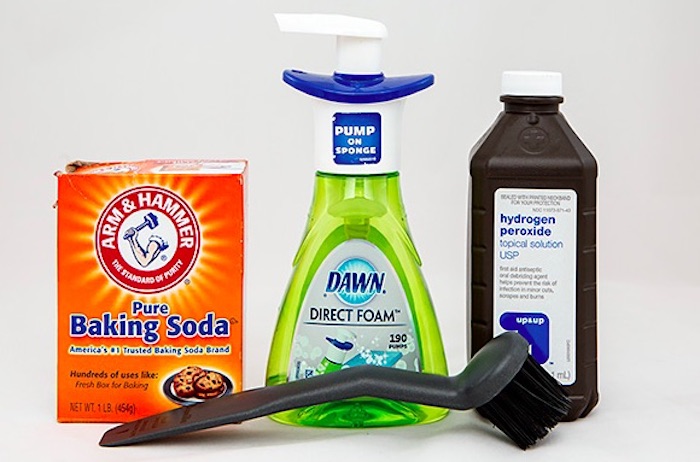
Step 4. Select Your Couch Type and Start Cleaning
Now that you’ve identified the type of couch you have and found its cleaning code on the care label, you’re ready to choose a cleaning solution based on the type of couch you have.
Couches and other upholstered furniture are typically either leather, fabric or synthetic (microfiber). Use the handy links below to jump to the section that deals with cleaning your specific type of couch.
💧 Pro Tip: If you don’t want to use harsh chemicals or are on a budget, you can make your own upholstery solution using a few items you can find in your kitchen.

How to Clean a Leather Couch
Leather is fairly durable and resists stains and wear-and-tear better than other types of couches. Although leather couches are generally easier to clean than fabric or microfiber, there are different types of leather that require special cleaning kits.
Since leather couches and cushions are so durable and stain-resistant, your biggest concern will be properly caring for and conditioning the leather. Before you do anything else, you’ll need to assess the condition of your couch to see if there are any areas that are more worn out than others. Worn leather reacts a little bit differently to water, oil and cleaners than new or less worn leather.
Need to get rid of a stained sofa? BOOK ONLINE ❯
Leather Cleaning Codes
Leather upholstery doesn’t typically have the cleaning codes that you’ll find on fabric or synthetic sofas. However, there are different types of leather. What you use to clean a leather sofa varies based on the type of leather your sofa is upholstered with.
Nubuck Leather Test: Run you hand over your couch. Does it change in shade or feel like velvet to the touch? If so, you probably have a Nubuck couch. Nubuck absorbs moisture easily, and requires a special Nubuck or Suede cleaning kit.
Suede Leather Test: Brush your hand along your couch. Does it feel soft but appears to be rough in texture? If so, you probably have a suede couch. Similar to Nubuck, Suede requires a special cleaning kit formulated specifically for this delicate and absorbent leather.
Aniline Leather Test: Use your fingernail to lightly scratch your couch. Does light pressure leave a scratch on your leather? If so, you probably have Aniline leather, which requires a special Aniline leather cleaning kit.
Finished Leather Test: This type of leather cannot be easily scratch and doesn’t change shades when you run your hand over it. If you have a finished leather sofa, you’ll need to get a solution formulated specifically for finished leather.
DIY Leather Care: For leather couches that aren’t Nubuck, Suede or Aniline, you can make a simple cleaning solution using common household items. If you decide against a leather cleaning kit, make sure you test the solution in an inconspicuous part of your couch. DIY cleaning solutions aren’t guaranteed and should always be spot tested before using them on your entire couch.
Steps to Clean a Leather Couch
Now that you’ve taken the initial steps for cleaning any type of couch, let the deep cleaning begin! Use the following steps to clean your leather sofa:
1. Select leather cleaner. Figure out what leather cleaning solution is best for your couch using the tips above. For a DIY leather cleaning solution, mix equal parts of vinegar and water in a bowl. (Always test a hidden spot before cleaning your whole couch.)
2. Use a clean towel to apply solution. Grab one of your clean, soft cleaning cloths. Dip the cloth in your solution and wring it out to remove excess water. Cloth should be damp, not soaked.
3. Wipe down your couch. Using your cloth, wipe down your leather sofa using a circular motion. Pay close attention to heavily-soiled areas and stains.
4. Dry it. Using a different cloth than you used to clean your sofa, wipe down any wet or damp areas with a clean, dry cloth.
5. Condition it. Once your couch has fully dried, conditioning the leather will protect it from drying out and cracking.
NOTE: Cleaning leather couch cushions require the same process and steps as cleaning the rest of your couch. Unlike other upholstery types, leather couches typically don’t have zip-off cushion covers that can be thrown in the wash.
Conditioning Your Leather Sofa
Since leather is naturally porous and susceptible to drying out and cracking, it’s important that you condition it after cleaning it. Deep conditioning a leather couch will keep it looking new and prevent it from cracking.
Steps for Conditioning Leather
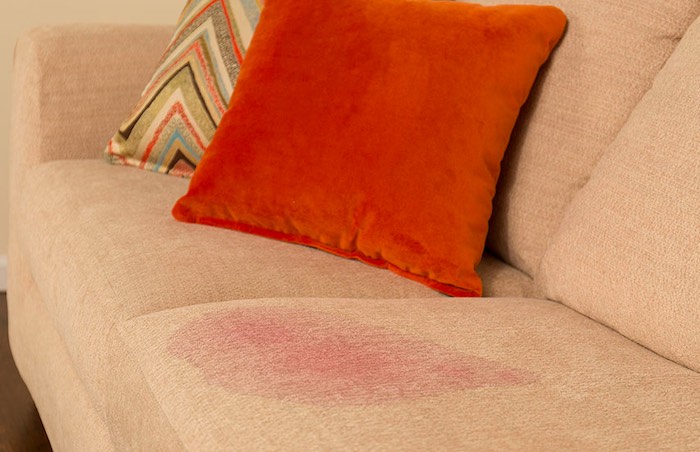
How to Clean a Fabric Couch
Fabric couches stain easily. If you don’t get to a spill in time, it will quickly set, making getting stains out of a couch much more difficult.
Now that you’ve followed the initial steps to prep your couch, you’re ready to dive into cleaning it using a solution for fabric couches. Remember, you’ll be using either a water-based solution or a solvent, depending on your couch’s specific cleaning code.
✨ Pro Tip: Use mild dish soap or a detergent + water mix to help clean couch stains, even the stubborn grease.
Steps to Clean a Fabric Couch
Follow these steps to clean your fabric sofa:
1. Sprinkle & vacuum up baking soda. Baking soda helps remove odors and loosen stains. Sprinkle it over your entire couch. To remove stains that are set in, make a mixture of equal parts water and baking soda and apply directly to stained areas. Let baking soda and/or mixture sit for 15-20 minutes before vacuuming.
2. Spot test cleaning solution. Even if you’re confident that you’ve chosen the right cleaning solution for your fabric couch, you should still test it in a hidden area before cleaning it fully.
3. Clean it. If your spot test was successful, go ahead and treat your entire couch. For the best results, you should always follow the instructions printed on the label.
4. Don’t forget the cushions! Most fabric couches have zip on cushion covers that can be removed and either machine washed or dry cleaned. Make sure to check your the label on your couch cushions for machine washing instructions.
4. Dry fabric couch with clean towel. Once you have cleaned and treated the stains on your couch, blot up any excess moisture using a dry, soft cloth.
6. Air dry it. Couches usually take about 24 hours to fully dry. You can speed this process up by using a fan.
Old sectional too tough to clean? BOOK OUR SERVICES ❯
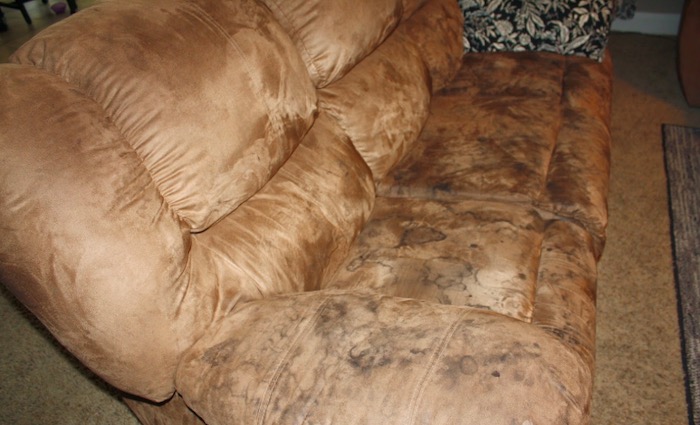
How to Clean a Microfiber Couch (Synthetic)
After working through the first steps, your microfiber sofa is ready for the couch cleaning solution. Follow these steps to clean your microfiber or synthetic couch:
1. Select your cleaning solution. Clear rubbing alcohol makes a wonderful solvent for cleaning microfiber furniture.
2. Spot test cleaning solution. You should always spot test your chosen cleaning solution or solvent in a hidden place before treating visible areas.
3. Spray and blot. It might be tempting to rub and scrub the stains on your couch, but you need to resist the urge. Scrubbing will damage your couch and can actually grind stains in deeper. Spray your solution over stains and use a clean towel to gently blot. Repeat as necessary until stains are gone.
4. Air dry. Allow your couch to dry for about 24 hours. You can speed up the drying process by using a fan.
5. Fluff up the fibers. It’s normal for microfiber couches to feel a little stiff after being deep cleaned. If this happens, use a soft brush to restore softness.
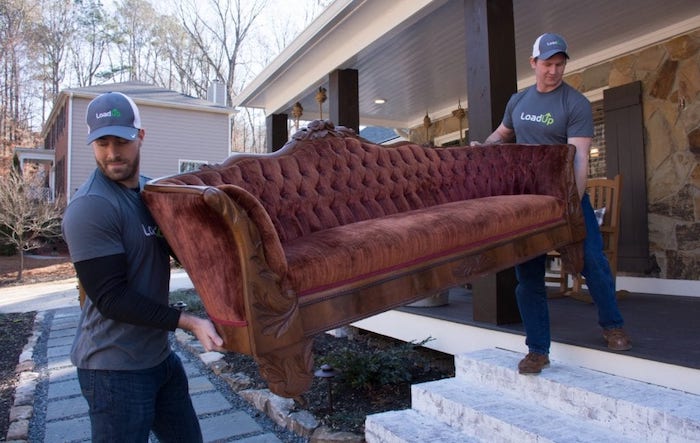
When a Couch is Too Dirty to Clean
Can’t remove a stubborn stain? Although we don’t have a magic wand to wave over your couch that will make it look new again, we do have the next best solution.
LoadUp’s nationwide couch removal service is the closest thing to a “magic wand” you can get. Because we offer next day service available in most local areas, LoadUp’s eco-friendly, professional junk removal team can have that dirty old couch out of your house in no time.
With upfront, guaranteed pricing and no on-site estimates, our competitive rates for junk removal service will save you time and money.
Couches are big and bulky, and shouldn’t be thrown out with your local trash. Sanitation companies often charge for special pickups, and require that you schedule a bulk pickup in advance. Your couch will then end up in a landfill, where it will sit for hundreds of years. Most couch cushions contain foam, which can pollute soil and groundwater while it slowly decomposes. Some foam will never decompose.
LoadUp is an eco-friendly company, meaning that we do our part to find the best disposal options for your unwanted items. As an industry leader, we always look for better, greener ways to keep as much stuff out of the landfill as possible. We’ve already diverted over 2.5 million pounds of trash from the landfill since launching in 2014.
Our company was built to disrupt the existing junk removal industry by offering exceptional service with honesty and transparency. Backed by a million dollar insurance policy, you can feel confident that our fully-background checked Loaders will respect you and your home.
Don’t settle for less when you can have the best. You deserve it!
Related Articles from the Trash Talk blog:

